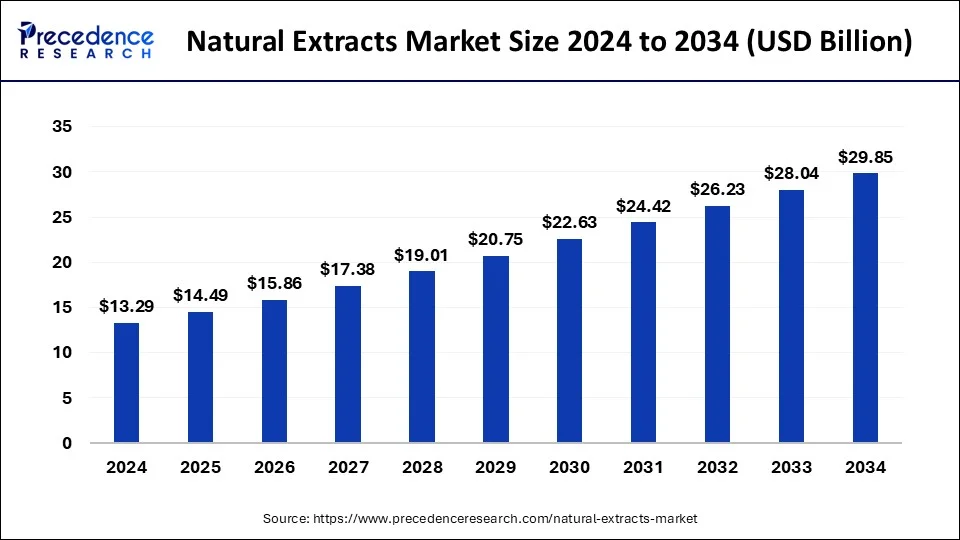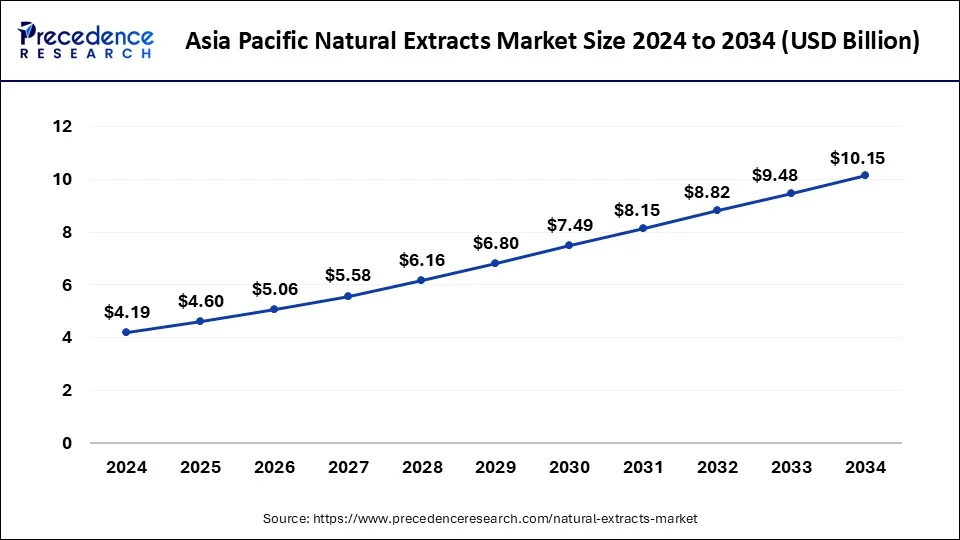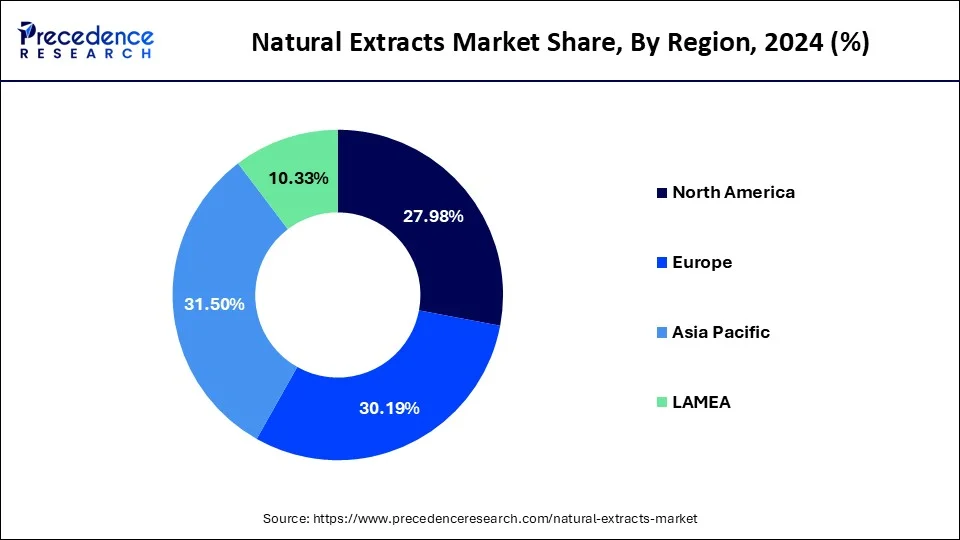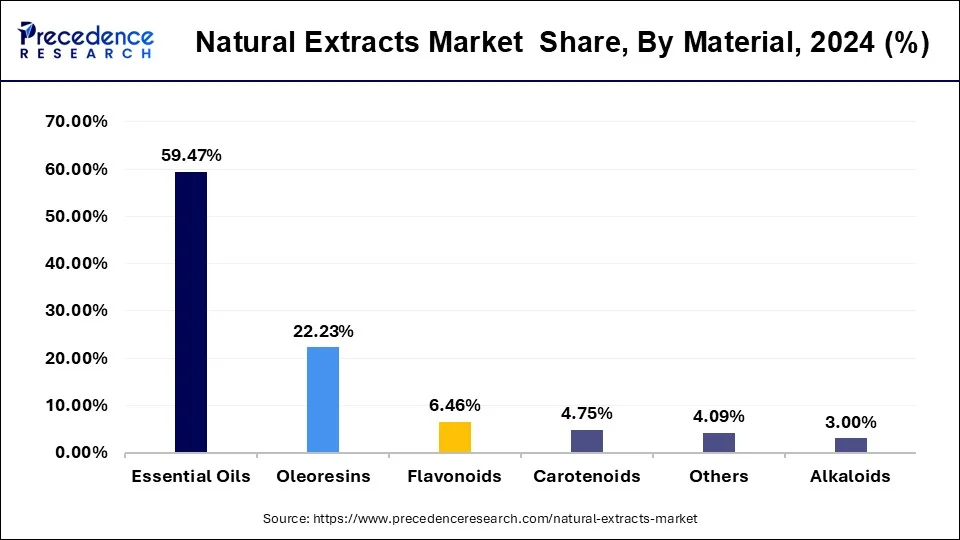List of Contents
Natural Extracts Market Size and Forecast 2025 to 2034
The global natural extracts market size was estimated at USD 13.29 billion in 2024 and is predicted to increase from USD 14.49 billion in 2025 to approximately USD 29.85 billion by 2034, expanding at a CAGR of 9.41% from 2025 to 2034.

Natural Extracts Market Key Takeaways
- Asia Pacific dominated the global market with the largest market share of 31.50% in 2024.
- By Material, the essential oils segment is expected to grow at the fastest rate in the market between 2025 and 2034.
- By therapeutic area, the nutraceuticals/ dietary supplements segment is projected to experience the highest growth rate in the market between 2025 and 2034.
- By application, the personal care and cosmetics segment is anticipated to grow with the highest CAGR in the market during the studied years.
- By product, the herbal and botanical extracts segment dominated the market.
- By product, the essential oils segment is expected to grow at the fastest rate in the market during the forecast period of 2025 to 2034.
How AI had been affected on the market?
Artificial intelligence is transforming the natural extracts industry by improving efficiency, precision and innovation across the value chain. In raw material sourcing, AI driven data analytics helps companies predict crop yields, assess quality, and identify optimal harvest times by analysing weather patterns, soil conditions, and satellite imagery. This predictive capability assures a steady supply of high quality botanicals while reducing waste. In extraction processes, AI powered automation enables precise control over temperature, pressure, and solvent use, resulting in consistent product quality and maximized yield. Machine learning models can identify the most efficient extraction methods for specific plant compounds, significantly cutting down trial-and-error time in research and development. In product formulation, AI accelerates the discovery of novel combinations by analysing large datasets on chemical compositions, functional benefits, and consumer preferences, allowing manufacturers to design targeted extracts for food, cosmetics, nutraceuticals, and pharmaceuticals. Additionally, AI supports quality assurance by rapidly detecting contaminants or deviations in chemical profiles using advanced spectral analysis. On the business side, AI-enabled demand forecasting helps companies align production with market trends, optimizing inventory and reducing overproduction. As sustainability gains importance, AI tools are also being used to track and verify supply chain transparency, assuring ethical sourcing and compliance with environmental standards. Collectively, these applications are enabling the natural extracts market to become more agile, innovation, and customer focused while meeting regulatory and sustainability goals.
Asia Pacific Natural Extracts Market Size and Growth 2025 to 2034
The Asia Pacific natural extracts market size was estimated at USD 4.19billion in 2024 and is predicted to be worth around USD 10.15 billion by 2034, at a CAGR of 10.34% from 2025 to 2034.

Asia Pacific region dominates the natural extracts market. The region includes major emerging economies such as China, India, and Japan, which have a high consumer base for natural & healthy products due to population and income growth. The natural extracts market is driven by an increase in favorable government initiatives regarding awareness about healthy lifestyles. For instance, since 2016, China has been implementing the “Healthy China 2030” policy to promote people's all-round development in the country. Moreover, an increase in production and supply of spices & herbs in India is also driving the market growth in the region. For instance, according to the India Brand Equity Foundation, in 2020-21, ginger export witnessed growth of around 47% from 2019-20, accounting for a 10% year-on-year growth of the total spices export.About 30.5% of the global revenuefor natural extracts was in the European region in 2024.The use of essential oils in cosmetics and fragrancesare widely used in the European countriesby the manufacturers in the European region.They useessential oils in the production. The global demand for the natural extracts is currently driven bytwo industries, which is the food and beverages and the personal care. In the developed economies, the demand for the floral extracts or the essential oil is more as the people have high standards of living.

Aromatherapy has a major application of the essential oilsand the aromatherapy sector is growing in the European nations. Germany, Austria, France and Switzerland are themajormarkets for aromatherapy.Other significant markets foraromatherapy areNetherlands and UK. Europe is an exporter and a manufacturer of pharmaceutical products that usenatural extracts. An increase in this areas agingpopulation is also expected to drive the demand for pharmaceuticals and neutraceuticals in this region. Constant research and developmental activities to produce natural products are expected to drive the marketand awareness about the concept of healthy aging and an increasinghealth consciousdiet is also driving the market. The deficiency of essential micronutrients, or the inclusion ofsynthetic productsin the US has led to an increase in the cases of obesity,cardiovascular diseases, Osteoporosis. Therefore, there is a great demand for plant extracts in food and beverages.
Market Trends
- Rising consumer preference for clean label plant based and chemical free products across food, cosmetics, and pharmaceuticals.
- Increasing integration of functional and therapeutic benefits of natural extracts in nutraceuticals and dietary supplements.
- Expansion of AI and advanced extraction technologies to improve yield, quality, and efficiency in production.
- Growing demand for sustainable and ethically sourced ingredients, driven by conscious consumer behaviour.
- Surge in customized formulations tailored to specific health, beauty, or wellness needs.
- Greater adoption of essential oils and botanical extracts in aromatherapy, personal care, and holistic health practices.
- Strategic partnerships, mergers, and acquisitions to expand product portfolios and strengthen supply chains.
- The increasing popularity of exotic and rare botanicals sourced from emerging markets to meeting niche demand.
- Rising focus on regulatory compliance and traceability to meet global safety and quality standards.
- Growth in e-commerce distribution channels, enabling direct to consumer sales of natural extract products.
Market Overview
Natural extracts are the ingredients that are derived from natural sources like vegetables, fruits, plants, grains, meat, or even seafood. These natural products provide an additional benefits to the consumers for better health, beauty, etc. The natural extracts are used in many applications like flavors, edible oils, colorants, etc. It is the most demanding ingredient for essential oils, fragrances, flavors and spices. It has great application in food and beverage industry and the pharmaceutical industry. These ingredients do not just provide flavor, but are also healthy as they serve many vitamins, carbohydrates and minerals. The unavailability of various raw materials and increased prices of these raw materials shall hinder the growth of the market.
Natural Extracts Market Growth Factors
Due to an increase in the trend of vegetarianism or veganism the natural extracts market is expected to boost. The increased consumer awareness, increased adoption of natural ingredient based products, change in the lifestyle and bio technological advancements are driving the market. The increase in the consumer's disposable income, research and development, growth of the agricultural industry, aging population, imports and exports and the growth in the population are all positively affecting the growth of the natural extracts market. Natural extracts are very popular among the consumers as they do not have any detrimental side effects like those that are chemical based. They see applications in personal care and cosmetics, food and beverage products and pharmaceuticals. The overall health benefits that are provided by the natural extracts are expected to create a demand for this product. In various industries due to increasing application in terms of flavors and fragrances. The North American region is the second highest market for the essential oils. The increased use of natural ingredients based product by all the consumers is expected to escalate the growth of this market.
MarketScope
| Report Coverage | Details |
| Market Size by 2034 | USD 29.85 Billion |
| Market Size in 2025 | USD 14.49 Billion |
| Market Size in 2024 | USD 13.29 Billion |
| Market Growth Rate from 2025 to 2034 | CAGR of 9.41% |
| Base Year | 2024 |
| Forecast Period | 2025 to 2034 |
| Segments Covered | Material, Therapeutic Area, Application, and Region |
| Regions Covered | North America, Europe, Asia-Pacific, Latin America, and Middle East & Africa |
Market Dynamics
Drivers
Rising Personal Disposable Income
Products containing natural extracts are gaining popularity among the consumers due to a rise in their disposable income. These extracts require advanced biotechnologies for extraction and processing. They also require proper supply chain and logistics for transportation, as these extracts are void of preservatives and other artificial ingredients to keep them fresh.
Moreover, an increase in personal disposable income around the world is accelerating the market growth, as consumers have high purchasing power and awareness of these products. For instance, according to the World Bank data, global GDP per capita increased from US$ 10,936.1 in 2020 to US$ 12,262.9 in 2021. Likewise, according to the Organisation for Economic Co-operation and Development, Gross per capita, percentage change of household disposable income in the U.S. grew by 2.54% in 2021 and the same rose in the U.K. by 0.79% in 2021.
Furthermore, a rise in income enables consumers to spend more on innovative products. Natural extract products include food & beverages, cosmetics such as hair care & skin care products, pharmaceuticals and others.
Health Benefits Associated with Natural Extracts
Natural extracts are widely preferred for food & beverages, personal care, and medicinal applications. Consumers are preferring these products to improve their lifestyles. Due to hectic working hours, reduction in physical activities, and rising adulteration in the products, natural extract is gaining popularity among consumers.
Moreover, consumers are choosing natural extracts according to their requirement related to health, which is also boosting the market growth. Natural extracts such as essential oils and oleoresins carry various health benefits for treating diseases as well as preventive care. People adopt natural products for preventing respiratory, digestive diseases, and other diseases such as asthma, cancer, diabetes, blood pressure fluctuations, headaches, and others.
An increase in the prevalence of diseases such as cardiovascular, chronic, respiratory and others is driving the market growth to treat and manage health issues. According to the American Diabetes Association, in 2019, 11.3% of the U.S. population i.e., 37.3 million had diabetes. Also, according to the World Health Organization, in 2020, cancer caused around 10 million deaths around the world. Likewise, according to May 2022 data of the same source, food contamination makes 600 million people in the world fall ill and 420,000 die every year.
Thus, due to the rising number of diseases, consumers are becoming more aware about their food consumption and maintaining healthy lifestyle, which is in turn driving the market growth.
Restraints
Availability of Low-cost Alternatives
The global natural extracts industry is rapidly growing; however, some factors such as the availability of low-cost alternatives limit the market growth. Currently, natural extracts are price sensitive as they go through advanced production methods and their availability is limited. They are commonly available in urban cities; however, due to supply chain & cold storage complexities, these products are not extensively consumed in rural regions. This results in the consumption of low-cost synthetic substitutes.
Moreover, other factors which make natural extracts price sensitive are crop yield, climate, import/export, agriculture laws, and others. Natural extracts are more expensive than synthetic & chemical counterparts due to high cost related to extraction, purification, and concentration processes. The aforementioned factors contribute to the high prices of natural extracts, which is expected to be a major restraint for the natural extracts market growth.
Market Opportunity
Increasing Adoption of Natural Extracts in End-use Applications
The growth in personal care & cosmetics, pharmaceuticals, food & beverages, and nutraceuticals applications is creating lucrative growth for natural extracts. These extracts have major benefits and uses in these applications, which have various benefits such as improving skin care, mental illness, food intake, and others. Thereby, many companies related to end-use applications are undertaking initiatives to expand the demand for organic and natural products.
Significant growth of the cosmetics market around the world is accelerating the market growth. For instance, according to France-based personal care company, L'ORÉAL's annual report of 2021, the growth of the global cosmetics market witnessed an increase from 4.9% in 2017 to 8.2% in 2021. Likewise, according to the Food and Agriculture Organization 2021 data, in 2019, the global sales of organic food and drink reached over US$ 107 billion.
Hence, the rising demand for natural ingredients for end-use applications is expected to create a profitable opportunity for the market growth over the forecast period.
Product Insights
The herbal and botanical extracts segment dominated the market in 2024. Their dominance stems from widespread applications across pharmaceuticals, food and beverages, cosmetics, and wellness products. Herbal extracts have a long standing reputation for their medicinal and functional properties, making them a trusted choice for consumers and formulators alike. They are also supported by a growing body of scientific research validating their benefits, which enhances consumer confidence. On the other hand, the essential oils segment is expected to grow at the fastest rate during the forecast period. This is largely due to their versatility, as they are used in aromatherapy, natural remedies, fragrances, and personal care products. Their growing popularity in wellness routines and holistic health practices is creating a strong upward trajectory for this product category.
Material Insights
The essential oils segment is expected to grow at the fastest rate in the market between 2025 and 2034. This growth is fuelled by the increasing incorporation of essential oils into aromatherapy, personal care, and functional food products. Their natural aroma, therapeutic benefits, and clean label appeal make them a preferred choice among health conscious consumers. The rising popularity of wellness trends, along with demand from the hospitality and spa industries, is further propelling the use of essential oils. Advances in extraction technologies are also improving yield and quality, making these products more accessible to wider audience.

Therapeutic Area Insights
The nutraceuticals and dietary supplements segment is projected to experience the highest growth rate in the market between 2025 and 2034. Growing interest in preventive healthcare and functional nutrition is leading consumers to seek products with proven health benefits derived from natural sources. Natural extracts are increasingly being used in supplement formulations for immunity, energy, and overall wellness. The preference for plat based and clean label products aligns perfectly with this segment, as consumer poetize safety, sustainability, and efficacy. Those demand is also supported by the expansion for e-commerce platforms that make such products easily accessible worldwide.
Application Insights
The personal care and cosmetics segment I anticipated to grow with the highest CAGR in the market during the studied years. The shift toward natural and organic formulations in skincare and cosmetics is a key driver. Consumers are increasingly avoiding synthetic chemicals. Opting instead for products with botanical extracts, essential oils, and other natural ingredients that promise both safety and efficacy. In addition, social media and influencer marketing adoption. Manufacturers are innovating the multifunctional extracts that combine cosmetic and therapeutic benefits, further strengthening this application segment.
Natural Extracts Market Revenue, By Application, 2022-2024 (USD Million)
| By Application | 2022 | 2023 | 2024 |
| Pharmaceuticals | 1,056.90 | 1,156.00 | 1,269.9 |
| Personal Care & Cosmetics | 3,304.20 | 3,603.70 | 3,947.1 |
| Food & Beverages | 4,999.00 | 5,426.10 | 5,914.7 |
| Animal Feed | 470.70 | 508.60 | 551.8 |
| Nutraceuticals | 749.60 | 833.10 | 929.5 |
| Others | 579.30 | 624.30 | 675.6 |
Natural Extracts Market Companies
- Flavex Naturextrakte GmbH
- Arjuna Natural Pvt. Ltd.
- Firmenich SA
- Robertet Group
- Sami Spices
- Synthite Industries Ltd.
- Ransom Naturals Ltd.
- India Essential Oils
- A.G. Industries
- Symrise
- Kancor
Recent Developments
- In a bid to expand its capabilities and regional footprint, Nordmann has formed new partnership with Ransom Naturals Ltd., a European producer known for its GMP accredited botanical extracts for food and beverages, covering markets in BeNeLux, access to high quality natural ingredients for consumer goods and pharmaceutical applications, singling a strategic move to enhance its supply chain and product offerings without taking over competitors.
(Source: Botanical extracts from new partner Ransom Naturals Ltd. - News - News & Events - nordmann.global) - Synsqo has completed the acquisition of a controlling stake in Azerys, a specialist producer of rosemary extracts based in Morocco. This move gives Synsqo access to Azery's established operations and expertise in Mediterranean botanicals, particularly rosemary, a highly valued aromatic used across food, cosmetic, and nutraceutical industries. By integrating Azery's capabilities into its portfolio, Syensqo positions itself to enhance production efficiency, expand its raw material base, and explore new product innovations rooted in rosemary's multifunctional benefits.
(Source: Syensqo Acquires Azerys, a Natural Rosemary Extraction Company • CHEManager is the market-leading medium for the management of the chemical and pharmaceutical industry )
Segments Covered in the Report
By Material
- Essential Oils
- Oleoresins
- Flavonoids
- Alkaloids
- Carotenoids
- Others
By Therapeutic Area
- Immunity
- Beauty & Aging
- Gastro & Digestive
- Weight & Wellness
- Mental Health
- Diabetes
- Woman Health
- Others
By Application
- Pharmaceuticals
- Personal Care & Cosmetics
- Food & Beverages
- Animal Feed
- Nutraceuticals
- Others
By Geography
- North America
- U.S.
- Canada
- Europe
- U.K.
- Germany
- France
- Asia-Pacific
- China
- India
- Japan
- South Korea
- Malaysia
- Philippines
- Latin America
- Brazil
- Rest of Latin America
- Middle East & Africa (MEA)
- GCC
- North Africa
- South Africa
- Rest of the Middle East & Africa
For inquiries regarding discounts, bulk purchases, or customization requests, please contact us at sales@precedenceresearch.com
Frequently Asked Questions
Ask For Sample
No cookie-cutter, only authentic analysis – take the 1st step to become a Precedence Research client